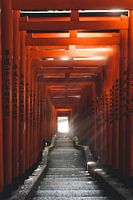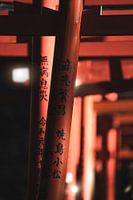Buy the photo traditional Japan by Endre Lommatzsch on canvas, ArtFrame, poster and wallpaper, printed on demand in high quality.
About "traditional Japan"
by Endre Lommatzsch
About the artwork
The architectural style of temples in Japan is characterised by a deep connection to nature, a harmonious integration of architecture and environment as well as a spiritual orientation towards the principles of Shintoism and Buddhism. Over the centuries, different styles and architectural features have led to a fascinating variety of temple buildings.
Traditionally, Japanese temples are made of wood, which allows for a certain lightness and flexibility in construction. This has also helped to adapt to natural disasters by allowing the structures to move flexibly during earthquakes. One example of this is the Byodo-in temple in Uji, which is notable for its wooden architecture and characteristic wing-like roofs.
Shinto temples, also known as jinja, are often characterised by their simple construction and the use of natural materials. Torii gates, which mark the transition from the profane to the sacred world, are a characteristic feature. The structures are often made of wood and covered with shingle roofs. The architecture is often modelled on traditional dwellings in order to maintain a connection to the earthly world.
Zen temples are known for their simple elegance and minimalist design. The integration of natural elements, such as gardens and rocks, is characteristic of the Zen building style. The main buildings are often kept simple to promote mental concentration. Ryoan-ji in Kyoto is a famous example of a Zen temple with a dry rock garden.

About Endre Lommatzsch
Hey, I'm Endre!
I was born in Budapest and now live in Mainz - and I'm neither a full-time photographer nor a travel influencer. My actual profession and my passion couldn't be more different. A few years ago, I grabbed my rucksack and my camera (which was almost 20..
Read more…
 Germany
Germany Ordered in May 2022
Ordered in May 2022
 Germany
Germany Ordered in January 2020
Ordered in January 2020
 Netherlands
Netherlands Ordered in February 2019
Ordered in February 2019
 Germany
Germany Ordered in March 2021
Ordered in March 2021
 Netherlands
Netherlands Ordered in December 2022
Ordered in December 2022
 Germany
Germany Ordered in November 2020
Ordered in November 2020
 Netherlands
Netherlands Ordered in January 2019
Ordered in January 2019
 Netherlands
Netherlands Ordered in November 2024
Ordered in November 2024
 Germany
Germany Ordered in May 2020
Ordered in May 2020
 Germany
Germany Ordered in May 2019
Ordered in May 2019
 Germany
Germany Ordered in August 2019
Ordered in August 2019
 Germany
Germany Ordered in January 2020
Ordered in January 2020
About the material
ArtFrame™
Interchangeable Art Prints
- High-quality print
- Easily interchangeable
- Acoustic function
- Large sizes available
Discover the artworks of Endre Lommatzsch
 Japanese torii gates in the evening sunEndre Lommatzsch
Japanese torii gates in the evening sunEndre Lommatzsch View of ManhattanEndre Lommatzsch
View of ManhattanEndre Lommatzsch Morning walk on the Brooklyn BridgeEndre Lommatzsch
Morning walk on the Brooklyn BridgeEndre Lommatzsch Radio City Music HallEndre Lommatzsch
Radio City Music HallEndre Lommatzsch a young lion and his mother I/IIIEndre Lommatzsch
a young lion and his mother I/IIIEndre Lommatzsch a young lion and his mother II/IIIEndre Lommatzsch
a young lion and his mother II/IIIEndre Lommatzsch Lucky cards in JapanEndre Lommatzsch
Lucky cards in JapanEndre Lommatzsch Tori gates in Japanese templesEndre Lommatzsch
Tori gates in Japanese templesEndre Lommatzsch Japanese temple complexEndre Lommatzsch
Japanese temple complexEndre Lommatzsch Japanese temple gardenEndre Lommatzsch
Japanese temple gardenEndre Lommatzsch Lucky cards in JapanEndre Lommatzsch
Lucky cards in JapanEndre Lommatzsch Brooklyn Bridge: A landmark through the agesEndre Lommatzsch
Brooklyn Bridge: A landmark through the agesEndre Lommatzsch Brooklyn Bridge: A landmark through the agesEndre Lommatzsch
Brooklyn Bridge: A landmark through the agesEndre Lommatzsch Brooklyn Bridge: A landmark through the agesEndre Lommatzsch
Brooklyn Bridge: A landmark through the agesEndre Lommatzsch Hyena: The underestimated predatorEndre Lommatzsch
Hyena: The underestimated predatorEndre Lommatzsch Malta - the historic pearl in the MediterraneanEndre Lommatzsch
Malta - the historic pearl in the MediterraneanEndre Lommatzsch Malta - the historic pearl in the MediterraneanEndre Lommatzsch
Malta - the historic pearl in the MediterraneanEndre Lommatzsch Malta - the historic pearl in the MediterraneanEndre Lommatzsch
Malta - the historic pearl in the MediterraneanEndre Lommatzsch Malta - the historic pearl in the MediterraneanEndre Lommatzsch
Malta - the historic pearl in the MediterraneanEndre Lommatzsch The rugged island of FuerteventuraEndre Lommatzsch
The rugged island of FuerteventuraEndre Lommatzsch













 Buddha
Buddha Forest
Forest Japan
Japan Photo wallpaper
Photo wallpaper Photography
Photography Serene Peace
Serene Peace Temple
Temple Tokyo (city)
Tokyo (city)









